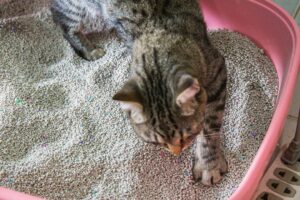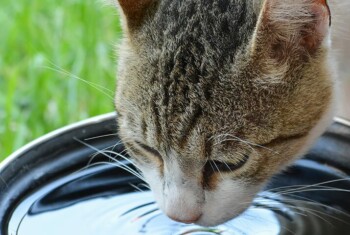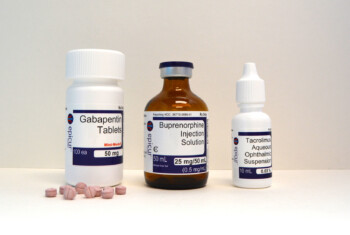Feline chronic bronchitis (feline asthma): Symptoms, diagnosis and treatment.
Feline chronic bronchitis, commonly called feline asthma, is a disease in cats affecting the smaller airways that branch out from the trachea (windpipe).
These branches, called bronchi and bronchioles, allow the transport of air into and out of the alveoli, the sites of oxygen exchange.
What is bronchitis?
Typically, inflammation within the airways results in excessive secretions that plug the airways. The end result is an impaired ability to bring oxygen into the alveoli for delivery to the rest of the body. Less commonly, the bronchi may close down because of constriction or contraction of the muscles in the walls of these airways (reactive airway disease).
Although the term “asthma” is commonly used to describe all forms of airway disease in cats, this term is somewhat misleading. Asthma specifically refers to the reversible constriction of muscle within the walls of the bronchi. Some cats have true asthma, whereas others have bronchitis due to other diseases (bacterial, viral or fungal infection, lung parasites, heartworm disease).
Bronchitis is associated with inflammation and swelling of the walls of the bronchi resulting in narrowing of the airways and obstruction or blockage of airways by plugs of mucus or other secretions.
Bronchitis can be acute (short duration) and associated with reversible changes in the structure of the airways or chronic (long duration, usually more than two to three months) and may lead to permanent, irreversible changes in the airways.
Bronchitis and asthma can occur at the same time. Chronic bronchitis may be caused by bacterial infections, hypersensitivity disorders (allergies), parasites (i.e., lung worms, heartworm, toxoplasmosis), or chronic inhalation of airway irritants. In many cases, the underlying cause cannot be identified.
Symptoms.
The most common signs of bronchitis in cats include constant, cyclic or seasonal coughing, difficulty breathing or wheezing. Episodes of coughing can mimic vomiting; you may think that your cat is vomiting a fur ball when in fact your cat is having a coughing fit followed by retching. Breathing may be  rapid (> 40 breathes per minute) or require excessive effort.
rapid (> 40 breathes per minute) or require excessive effort.
Some severely affected cats may show open-mouth breathing, especially after periods of physical exertion. If you notice any of these signs, your pet needs immediate medical attention. These signs are not specific for bronchitis and can also be seen with many other diseases such as heart failure, pneumonia, pleural effusion (fluid in the chest) and heartworm disease.
Diagnosis.
To diagnose feline bronchitis, usually the first test is a chest radiograph (x-ray). Bronchoalveolar lavage (BAL) may be recommended. This procedure allows collection of fluid and cells from your cat’s lungs. These samples are sent out to a laboratory to determine what types of cellular changes are occurring in the lungs.
If bacterial or parasitic infection is present, the results will help assist in determining what therapy might be most effective. Bronchoalveolar lavage does require anesthesia, so if the patient’s condition is critical, it may not be possible to perform this procedure because of increased risk of death.
Treatment.
Any underlying disease (i.e., bacterial or parasitic infection) must be diagnosed and treated. Changes may be needed in the cat’s environment.
Cats with bronchitis often have sensitive, hyperactive airways, and the inhalation of irritating particles from certain environments may worsen their condition. It is  strongly recommended that their exposure to smoke (cigarette or fireplace), dust (kitty litter, carpet fresheners, flea powder), and sprays (insecticides, hair spray, perfumes, and cleaning products) be eliminated or minimized.
strongly recommended that their exposure to smoke (cigarette or fireplace), dust (kitty litter, carpet fresheners, flea powder), and sprays (insecticides, hair spray, perfumes, and cleaning products) be eliminated or minimized.
Two classes of medications are commonly prescribed: bronchodilators (typically beta agonists including albuterol or terbutaline and corticosteroids (prednisolone, fluticasone, dexamethasone, and methylprednisolone).
Bronchodilators help to dilate or open the airways by relaxing the muscular walls. Possible side effects of bronchodilators in cats may include vomiting, nausea, restlessness and lethargy.
Corticosteroids are anti-inflammatory drugs that decrease the inflammation and swelling of the airway walls. Side effects of corticosteroids may include increased appetite, increased urination, increased thirst and anxiety (pacing, restlessness). Corticosteroid inhalers and bronchodilator inhaler therapy are highly effective; however, patients are not always cooperative.
Prognosis.
The prognosis is variable with this disease. If an underlying disease can be identified and successfully treated or eliminated, the prognosis is excellent. If permanent damage to the airways has occurred, the disease cannot be cured.
With proper medical management, clinical signs can usually be controlled and the damage to the bronchi can be stopped or slowed. Some cats having a sudden severe asthma attack may die despite intensive medical efforts.


